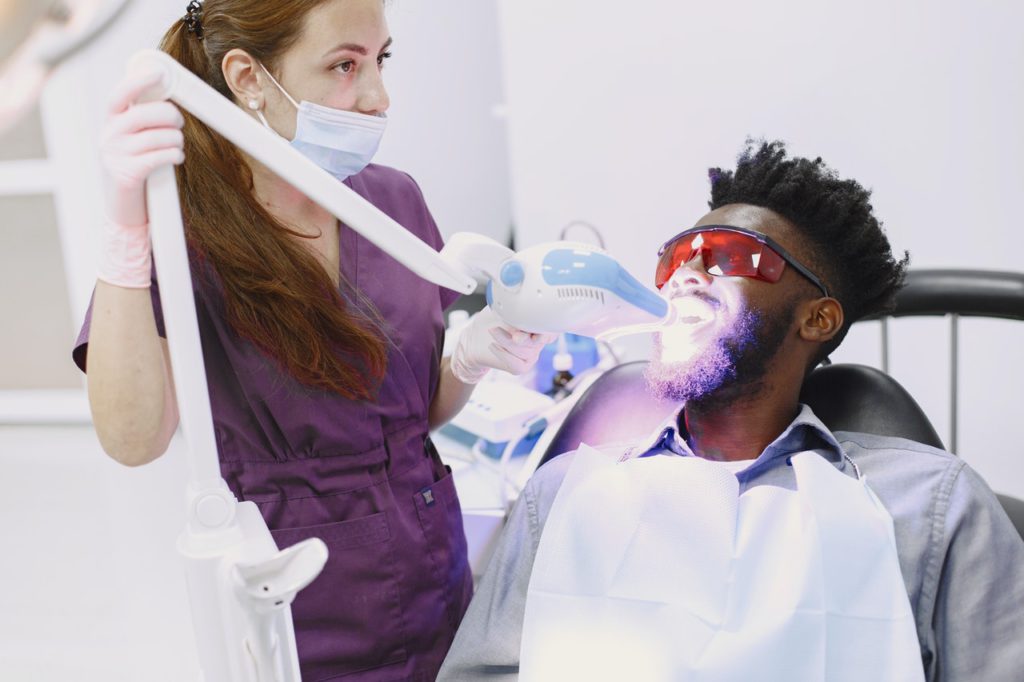
While the Journal of Evidence-Based Dental Practice (open in new tab) has some insight into whether whitening teeth professionally using bleaching agents makes a difference, many are looking at natural remedies for getting that shiny smile. The American Dental Association (opens in new tab) reports that when people are asked what they most want to improve about their smile, whiter teeth are a high response. A 1998 study in The Journal of Clinical Dentistry (opens in new tab) found that using toothpaste that contained baking soda led to whiter teeth than toothpaste that did not. A more recent study found that strawberry-bicarbonate mix produced very small changes in the color of teeth when compared to commercial bleaching products.
Whitening advocates say the malic acid found in strawberries will strip the color off of teeth, and baking soda polishes off the stain. DIY Whitening claims that brushing your teeth with ingredients such as activated charcoal teeth whitening or a baking soda-hydrogen peroxide paste will restore the sparkle to your smile.
In addition to using it as a mouthwash, you can also mix hydrogen peroxide with baking soda to create a paste you will use for teeth cleaning. You can either opt for the usual toothpaste made from baking soda, or you can make your paste by mixing the powder with water, but you do not get the benefit of adding fluoride to prevent cavities if you take the DIY route. The best way to bleach teeth is at home using low-concentration hydrogen peroxide gel, which is recommended by dentists and used in dental-prescribed mouth guards.
Baking soda helps get rid of the plaque on your teeth, and hydrogen peroxide is an antibacterial agent that whitens your teeth and keeps germs away. Science has yet to prove that a simple baking soda toothbrush whitens your teeth, but a few studies show toothpaste containing baking soda does have significant whitening effects. Many think using baking soda for brushing is a safer alternative than bleaching products, but in reality, it is more physically abrasive, while bleaching products use chemicals.
Most teeth-whitening products use chemicals to bleach the teeth, something many people are concerned about. Before starting any type of teeth bleaching treatment, it is important to ensure that your teeth are healthy. Healthy gums and teeth free from cavities are two requirements needed before starting whitening, so seeing a dentist can help ensure that these things are present. Ask your dentist for recommendations on the best toothpaste for bleaching teeth at your next appointment.
Have a dental hygienist properly clean your teeth before you need a whitener. If you are looking for ways to naturally whiten your teeth, properly cleaning your teeth and limiting your exposure to substances that stain the teeth may help. By practicing proper brushing techniques, you can protect your teeth’ enamel, and by doing so, you will prevent further staining. When your teeth’ enamel, or outermost layer, is damaged, your teeth are far more prone to stains.

Certain foods can stain your enamel, the outermost layer of your teeth. Acidic foods can cause teeth to appear yellow, wearing away the enamel. Acids in apple cider vinegar and fruits, as well as the abrasiveness of activated charcoal, may damage tooth enamel.
Rinsing does not change whitening, per se, but lauric acid found in coconut oil may cleanse the teeth of bacteria found in plaque, which may cause yellowing. Unlike many other methods for teeth whitening at home, pulling coconut oil does not expose your teeth to acids or other ingredients that can break down the enamel. Coconut oil is a natural teeth bleacher that may do wonders for your smile. As seen, baking soda is an abrasive, which will help to polish off the surface stains. Coconut oil is a strong natural teeth whitener and it can be used in multiple ways for achieving varying degrees of results. All you have to do to make a whitening toothpaste with essential oils is mix equal parts peppermint oil, coconut oil, spearmint essential oil, baking soda, and cinnamon bark oil.
Once you have created your essential oil toothpaste, you can use it to brush your teeth at least twice per day, and you will see just how powerful the effects it has on your teeth. When applied on teeth, and mixed with a little bit of salt, it acts like a perfect natural bleacher. Oil pulling is no replacement for normal brushing or flossing, but some studies show that washing your mouth with some oils can help to whiten your teeth.
Ways to whiten teeth naturally, as well as protect the enamel, include using coconut oil pulls; eating a healthy diet; brushing and flossing; staying hydrated, and trying activated charcoal. The type of toothpaste you use, along with regular brushing and flossing, using baking soda, coconut oil pulling, and eating a tooth-healthy diet, can all whiten your teeth naturally – as well as offering benefits such as antibacterial and antiseptic protection. Proven to whiten teeth in as little as three days, try this Arm & Hammer Natural Whitening Toothpaste.
DIY Whitening Keep it at Home You can use everyday pantry staples that are naturally acidic (like lemon, orange, and apple cider vinegar), have digestive enzymes (like pineapple or mango), and are abrasive (like baking soda) to whiten and brighten your teeth. In addition to apple cider vinegar, some swear by using citrus fruits–including lemon and/or orange peels, or citron essential oil, which contains useful acids. Some teeth whiteners are simply not worth using, particularly lemon juice.
Before doing any whitening, even using off-the-shelf products, you should get your teeth checked by a dentist to look for any dental problems, like cavities or cracks, that may make your gums feel irritated while whitening. Using high-quality fluoride toothpaste from your dental office will help restore and seal pores back into your teeth. Rinses may eliminate any stains-causing residue on your teeth surfaces.